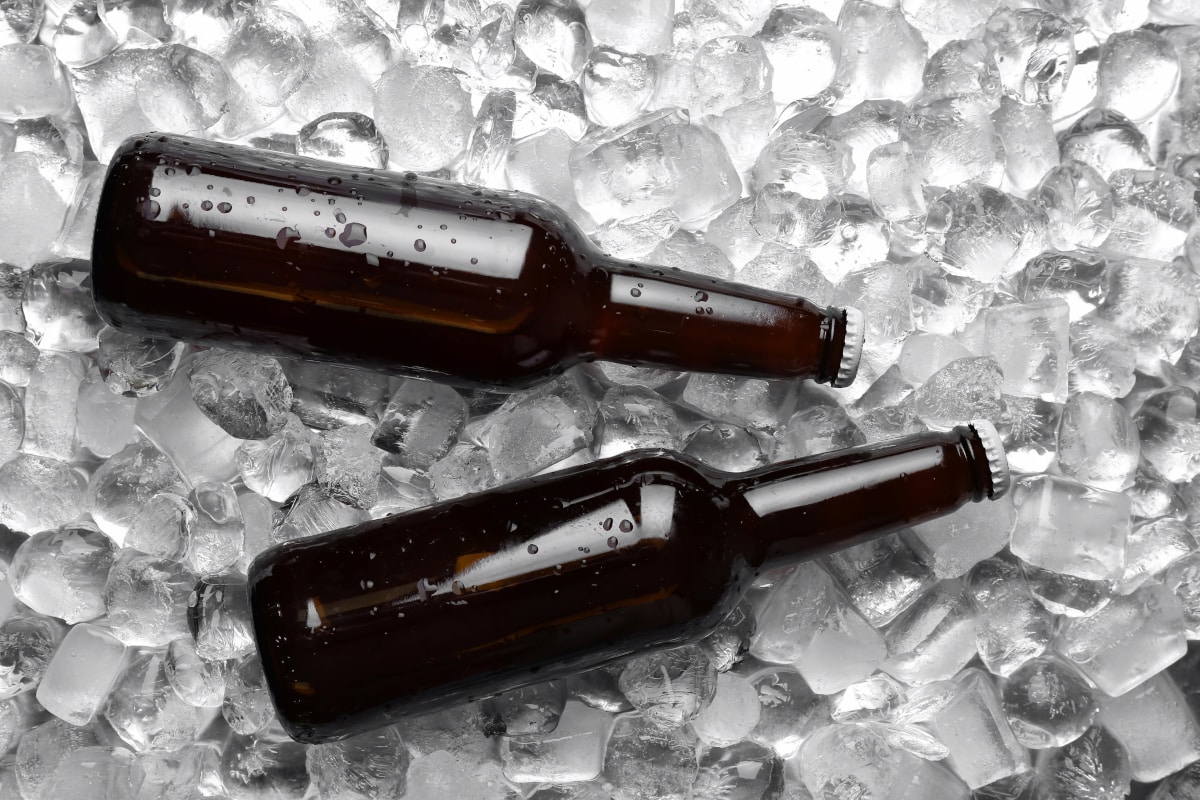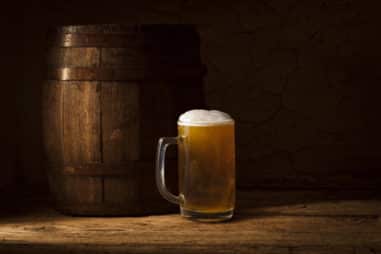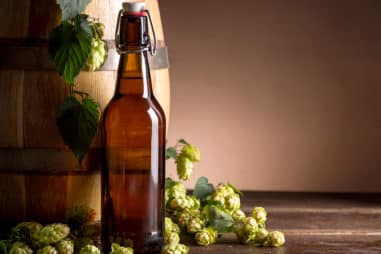Is cold crashing solely for making your beer crystal clear? Mostly, yes. However, there are other benefits to cold crashing that may surprise you.
There’s a reason why a lot of homebrewers adopt cold crashing in their brewing process. Some even regard it as a required step. But after reading this guide, you’ll be free to decide whether it’s for you or not.
What Is the Purpose of Cold Crashing?
The purpose of cold crashing is to accelerate the process of removing sediment or suspended particles in your beer. Cold crashing “forces” yeast particles to clump together and drop out of the solution.
The end result is crystal clear beer. Now, you might be wondering…are there any flavor benefits to cold crashing? So far, not so much. Nevertheless, it’s a simple process that requires 1 thing: a fridge.
Does Cold Crashing Clear Beer?
Yes, cold crashing helps clear your beer. During a cold crash, all the heavy particles in suspension fall to the bottom. These heavy particles left unfiltered could create a cloudy or hazy appearance in your beer.
Because cold crashing encourages these particles to fall out of suspension, you get a crisper, cleaner beer. Not to mention, the clarity of cold crashed beer has a striking appeal to it. And, it’s even known to be indistinguishable from commercial beers.
How Does Cold Crashing Work?
First, you need to understand flocculation. Flocculation is a term used to refer to yeast cells clumping together during the fermentation stage of beer. When yeast cells clump, they can either rise to the surface or fall to the bottom of your fermenter.
Now, when does flocculation happen? It happens when the proteins in yeast (also known as flocculins) stick out their cell walls and attach to the cell walls of other yeast cells.
When brewers categorize yeast, they categorize it by how soon the yeast flocculates:
- High flocculation yeast: Yeast that clumps early (usually 3 to 5 days).
- Medium flocculation yeast: Yeast that clumps further during fermentation (6 to 15 days).
- Low flocculation yeast: Yeas that clumps late (usually after 15 days).
So, what does this have to do with cold crashing? For starters, using low flocculating yeast means you’ll see more yeast particles in suspension. Why? Because low flocculation yeast takes a while before it clumps together and drops to the bottom.
This is where cold crashing comes in.
Cold crashing encourages or forces yeast particles to clump together. When these yeast particles clump together, they sink to the bottom of your fermenter or fermentation vessel.
The keyword here is “encourages”. Without cold crashing, the yeast particles remain suspended in your beer. It’s one of the reasons why you might see a hazy or cloud appearance in your beer.
Sure – over time, yeast particles eventually sink to the bottom. However, the way cold crashing works is it accelerates the process of yeast particles sinking to the bottom. And the way it does this is by dropping the temperature of your beer to about 33°F (0.6°C) to 40°F (4.4°C).
Does Cold Crashing Affect Flavor?
Cold crashing doesn’t affect the flavor of your beer. An experiment conducted by the team at Brulosophy did a study on the effects of cold crashing on beer’s flavor.
They brewed 2 types of beer. One that was cold crashed and one that wasn’t. The results revealed there was no difference in flavor between cold crashed beer and beer that wasn’t cold crashed.
If you want, you’re free to try it for yourself too.
When Should I Cold Crash My Beer?
You should cold crash your beer after fermentation is complete. This is important. You can only cold crash beer once your beer has fermented. Why is that so?
Remember how cold crashing works? It accelerates the process by encouraging yeast particles to sink to the bottom by dropping the temperature of beer.
The temperature ranges between 33°F (0.6°C) to 40°F (4.4°C). Once your beer hits this temperature, fermentation stops. And once fermentation stops, it means your yeast stops working too. If you cold crashed beer during fermentation, you prevent your beer from fermenting.
Confused? Here’s what you need to understand.
For yeast to work or do its job, it needs to be pitched at the right temperature. With the right pitching temperature, your yeast is active and awake. Without the right temperature, you either kill your yeast or, in the case of cold crashing, cause your yeast so sleep.
That’s the main reason why you should cold crash your beer after fermentation. And the best way to know fermentation is complete is through a hydrometer. After checking your beer’s final gravity, you’ll be able to tell whether fermentation is complete or not.
How Important Is Cold Crashing?
If you’re the type of homebrewer who prefers to remove as many suspended particles in your brew, then…
Cold crashing is without a doubt important. But that’s not the only reason why it’s important. Apart from being able to achieve a crystal clear appearance in beer, there are other benefits:
- Cold crashing prevents bottling or packaging beer with a lot of sediment in it.
- After a cold crash, it’s easier to siphon beer. When all the suspended particles fall to the bottom, you can siphon beer without worrying about clogging your auto-siphon. Basically, it helps you perform a clog-free transfer when you’re racking beer.
- If you’re doing a closed transfer process using a conical fermenter, the process is much smoother after a cold crash.
- Since cold crashing allows you to remove more sediment from the beer, it adds stability to your beer. Not to mention, the shelf life is longer and the flavors maintain their consistency longer.
Is Cold Crashing Essential?
From a homebrewer’s perspective, this can vary for every homebrewer. Ultimately, it depends on how you look at cold crashing.
If you look at a cold crashing as solely a means to achieve a beer that looks darn pretty, well…it’s obvious that it may not be as essential.
However, that’s not the true benefit of cold crashing. Yes – it helps achieve crystal clear beer, but the science behind it goes deeper than that. And it’s that cold crashing is a step that happens before bottling or packaging your beer.
Because of that, it allows you to remove yeast particles, protein particles, and even a few contaminating agents from your beer. As a result, you get a more stable and longer-lasting beer. Not to mention, a better-tasting product overall.
So, is cold crashing essential? As a homebrewer, yes it definitely is.
Is Cold Crashing Required?
Cold crashing isn’t required. It’s not a mandatory step that homebrewers must implement. But take note that all it takes is storing your carboy or keg in a fridge.
Even without a fridge, you could cold crash in an ice bath. Heck, if the weather’s cold enough, go ahead and cold crash outside.
There’s another thing worth mentioning. If it means making your beer sediment-free or having a lot less sediment, then why not right?
Do I Have to Cold Crash My Beer?
It’s completely up to you whether you want to cold crash your beer or not. As mentioned earlier, it’s not necessary for the brewing process.
However, for heavily dry-hopped beers, cold crashing does come in handy. Why? First off, sediment isn’t always just yeast particles. Sometimes, it could be yeast and protein particles. Protein particles come from the massive number of hops and grains used in the brew.
Imagine seeing yeast particles and protein particles. It’s only safe to assume your beer will look cloudy or even murky.
If you don’t enjoy drinking sediment or get frustrated with having to wait for the sediment to settle before drinking your beer, then…
Don’t you think that’s a good reason to cold crash your beer?
How Long to Cold Crash Beer?
Cold crashing beer usually takes 2 to 3 days; however, some are able to achieve their preferred clarity in 24 hours.
Now, here’s an interesting question. Is it possible to cold crash in less than 24 hours? Say, half a day? To tell you the truth, it’s unlikely.
Even commercial breweries can’t lower their beer’s temperature in less than a day, economically. At best, chilling beer to a temperature between 33°F (0.6°C) to 40ºF (4.4°C) takes roughly 12 hours.
By the time your beer has reached its ideal temperature, you have to give it time for the particles to settle. The best way is to check if your beer has reached your preferred clarity. For the majority, this takes up to 2 to 3 days.
There’s also one more thing to note. The time it takes to cold crash beer ultimately depends on how cold your beer gets.
If you refrigerate it and maintain it at a temperature of 33°F (0.6°C) to 35ºF (1.7°C), then cold crashing could take 24 hours. However, if you’re using different methods like a cool box or ice bath, cold crashing should be longer, reaching up to 3 or 4 days.
The reason is, an ice bath or a cool box isn’t going to get your beer as cold as a fridge, chest freezer, or kegerator.
How Fast Should You Cold Crash?
There isn’t a set timeline for how fast or how slow you should cold crash. Cold crashing isn’t about how fast you can finish. Even if you managed to bring your beer’s temperature down rapidly, speed doesn’t determine the quality of your beer.
It’s the time you allow for the particles to settle and fall to the bottom of your fermenter. After all, homebrewing isn’t about how fast you can make beer.
Even centuries back, it’s always been about the flavor, aroma, and overall quality of beer. Sure, there might be a few innovative techniques to speed up the process a little. However, there’s a reason why fermenting beer doesn’t and cannot happen in one day.
And that’s because it takes time for the yeast to do its work. It’s the same reason why it takes time to extract the most out of your hops to achieve the rich aromatics you love in beer.
How fast should you cold crash? The shortest timeframe you can go is about 1 day. But if you check your beer after a day and see it’s not as clear as you thought, give it another day or two. There’s no harm in doing so anyway.
Can You Cold Crash Too Long?
There’s no such thing as cold crashing for too long. However, that doesn’t mean you can simply go overboard and cold crash for an entire month.
In one of the many beer forums nowadays, one homebrewer mentioned cold crashing his strawberry blonde for a week. The result? It still imparted a strong strawberry flavor. In other words, cold crashing for a week didn’t alter the flavor of his beer.
If you’re worried that cold crashing might strip off any flavors or aroma, that’s hardly the case. What you should take note of, though, is the carbonation time.
When you cold crash beer, you also extend the time it takes to carbonate beer. Why? Because there’s less yeast in your beer. And because there’s less yeast in your beer, then it means there’s not a lot of yeast available to carbonate your beer.
Is that a bad thing? Not at all. When carbonating beer after a cold crash, expect your beer to finish carbonating after 1 to 2 weeks.
Can You Cold Crash Any Beer?
Whether it’s a pilsner, lager, or IPA, go ahead and cold crash your beer. For beers that use a lot of hops in the brewing process, it’s even more beneficial to cold crash.
Why? As mentioned earlier, sediment isn’t just yeast particles. It could also be protein particles due to the massive number of hops and high-protein grains used.
Ever brew a NEIPA? It uses a ton of hops and high-protein grains. During the brewing process, the hop oils or polyphenols found in hops bind to the protein in the grains. This results in a protein-polyphenol bond also known as colloidal haze.
These colloidal haze particles along with the yeast particles become the sediment that floats in your beer. And that’s just one example. After all, you can cold crash every beer you brew from now on.
This way, it should help you siphon and rack beer without worrying about clogging your auto-siphon. Not to mention, all the sediment will be sitting at the bottom of your fermenter after a cold crash.
Should You Cold Crash a Lager?
Cold crashing a lager is totally fine. But if you’re not comfortable doing so, you don’t have to cold crash your lager either.
The effect cold crashing has on a lager is the same as for every other beer style. And that’s dropping more sediment and achieving clearer beer.
It’s a matter of preference, really. Some prefer to add gelatin to achieve good beer clarity. However, there’s one thing to note about adding gelatin if you’re bottling.
Gelatin can actually make your sediment looser once added to your bottles. At first, your lager will look crystal clear. But when you take the beer cap off and pour your beer, the sediment will rise and turn your beer cloudy.
So, if you want crystal clear beer, there’s no harm if you introduce cold crashing when brewing a lager. The main concern, though, is the right time to cold crash a lager.
When Should You Cold Crash a Lager?
You should cold crash a lager after fermentation is complete and after you’ve performed a diacetyl rest. You remember diacetyl, right? The off-flavor in beer that tastes like butterscotch?
When brewing a lager, it’s essential to perform a diacetyl rest. Why? To eliminate diacetyl from your beer. Compared to ales, only lagers need a diacetyl rest. This is due to the temperatures that lagers are fermented at.
Lagers are fermented at temperatures between 48°F (8.9°C) and 55°F (12.8°C). Ales, on the other hand, are fermented at temperatures between 68°F (20°C) to 72°F (22.2°C). In temperatures between 68°F and 72°F, yeast can reabsorb diacetyl. However, at temperatures between 48°F and 55°F, yeast can’t reabsorb diacetyl.
So, remember: If you plan on cold crashing your lager, make sure to perform a diacetyl rest first. Then, check if fermentation is complete. Only then can you cold crash your lager.
Do You Need to Cold Crash Lager?
Not necessarily. It all boils down to your preference. If you prefer to remove as many sediments as possible from your homebrew, cold crashing is a solid option.
For any beer style, cold crashing isn’t necessary at all. However, many homebrewers have adopted cold crashing as part of their brewing process for the benefits it provides.
For example, wouldn’t you want a lager that’s essentially more stable both in flavor consistency and shelf life? Not to mention, all it takes is placing your fermenter in a fridge and maintaining the proper temperature over 2 or 3 days.
When you think about it like that, why not cold crash right? But for others who prefer to keep their homebrewing process as simple as possible, it’s also fine if you don’t want to cold crash.
How Long to Cold Crash Lager?
Cold crashing a lager should take between 2 to 3 days. Some might extend the cold crash a little longer – about 4 or 5 days. As mentioned earlier, the time it takes to cold crash beer depends on how cold your beer gets.
The same goes for lagers. If you don’t have a fridge, using a cool box or an ice bath will still get the job done. The only difference between a fridge and an ice bath is that cold crashing will take longer in an ice bath.
At most, an ice bath might be able to bring your beer to about 40ºF (4.4°C) gradually. But again, this is also nothing to be concerned about.
Do You Cold Crash Ales?
The same concept and explanation for whether you should cold crash lagers also applies to ales. It’s all a matter of personal preference.
You can skip cold crashing and still make a great ale. Really, cold crashing isn’t limited to just one style of beer.
And it’s also harmless because it doesn’t alter or change the flavor of your beer in any way.
When Should I Cold Crash an Ale?
Unlike lagers, ales don’t need a diacetyl rest before cold crashing. That means you should cold crash an ale after fermentation is complete.
Make sure to use a hydrometer to check if you’ve reached your final gravity. If not, wait a couple more days and check again. Once you’ve reached your brew’s final or terminal gravity, you can cold crash your ale.
In addition, feel free to cold crash straight from your fermenter. If you’re kegging, it’s a common practice to cold crash directly in the keg. For homebrewers that are bottling, transferring to a secondary fermentation vessel is an option. It’s not always necessary, though.
One benefit of transferring your beer to a secondary fermentation vessel or carboy is removing sediment.
Yes – you can remove sediment when you rack beer if you’re careful. Then, once cold crashing begins, you’ll be able to remove even more sediment.
Another way of looking at it is transferring beer from your primary fermenter to your bottling bucket. That way, after cold crashing, you can siphon beer from your bottling bucket into your bottles and prep for carbonation.
Should You Cold Crash an IPA?
Yes, you can definitely cold crash an IPA. Just think of a crisp and bright-looking West Coast IPA as an example. That’s startling clarity for you.
It’s also worth remembering that IPAs use a ton of hops in the brewing process. And that means a considerable amount of excess protein and yeast particles. With all that excess yeast and protein floating in your beer, cold crashing should help those particles drop out.
How Long Should You Cold Crash an IPA?
You can cold crash your IPA for 3 to 5 days. Some homebrewers go as far as cold crash for a week, even. Now, don’t worry. There’s really no specific cold crash timeline you have to follow.
It’s all about cold crashing your IPA until it reaches your preferred clarity.
Should You Cold Crash a New England IPA?
If you’re thinking about whether you should or shouldn’t cold crash a NEIPA, cold crashing would help significantly. NEIPAs use a lot of hops along with a massive heap of grains. You can expect how much trub is going to sit in your fermenter after fermentation.
That means you’ll see a lot of excess yeast and protein particles floating in your beer.
But here’s the difference. NEIPAs are classified by their juiciness, fruitiness, and hazy/cloudy appearance. In other words, NEIPAs aren’t crystal clear like your West Coast IPA.
So why cold crash?
For one, skipping a cold crash doesn’t mean you won’t get crystal clear beer. There are several ways to achieve clarity in beer. Let alone, your beer’s clarity does improve over time while it’s in the bottle.
For a NEIPA, the reason for cold crashing isn’t to achieve a crystal clear NEIPA. It’s simply to help you remove excess yeast and protein particles floating in your beer. In addition, it’s going to help you siphon your NEIPA from your bottling bucket to your bottles.
The more suspended particles there are in your beer, the higher the chance of it clogging your auto-siphon. And surely, you don’t want that to happen, right?
How Long Should You Cold Crash a NEIPA?
Cold crashing a NEIPA takes between 2 to 3 days. Remember. The goal of cold crashing a NEIPA isn’t to turn it crystal clear. It’s to reduce trub and suspended particles in your beer.
The haziness you get from a NEIPA shouldn’t be from your trub or sediment. It should be from the protein and polyphenols from your grains and hops.
Sometimes, you might be able to finish cold crashing a NEIPA after 1 day. But even if your NEIPA looks clear, be sure to taste it first. If you taste any hop burn, let it sit in the fridge for an extra day or two.
Should You Cold Crash a Hazy IPA?
By all means, go for it. You can cold crash a Hazy IPA without worrying about losing its haze. The majority of homebrewers who cold crash a Hazy IPA will have similar reasons for doing so:
- To remove any trub sitting at the bottom of their fermenter.
- The haziness of a Hazy IPA or NEIPA shouldn’t come from the yeast or suspended particles. Cold crashing helps with that.
However, if you’re not comfortable cold crashing your Hazy IPA, you don’t have to do so either. Some homebrewers prefer to skip cold crashing while some enjoy the taste of sediment.
Either way, you can cold crash a Hazy IPA without any issues with your beer. Or, you can skip cold crashing and your Hazy IPA will still turn out great.
How Long Should You Cold Crash a Hazy IPA?
Much like a NEIPA, you should cold crash a Hazy IPA for about 2 to 3 days. As mentioned earlier, make sure to always check if your beer is ready for carbonation.
With a Hazy IPA or NEIPA, you can’t exactly use clarity as the determining factor for when cold crashing is complete. That’s because Hazy IPAs and NEIPAs are hazy, to begin with.
So, as a general rule of thumb, give it 2 to 3 days. If you want to extend for an extra day or two, that’s fine as well.
Just remember to taste your Hazy IPA first. If you taste any hop burn on the 2nd day, one more day should be fine.
Should You Cold Crash a Wheat Beer?
Some homebrewers ‘crash’ their wheat beer. Some don’t because they prefer to retain the cloudiness and sediment taste you get from a wheat beer. However, not all wheat beers have to be cloudy.
If you’ve ever tried a Kristal Weizen, it’s not as cloudy as you would expect for wheat beer. There’s no flavor benefit to cold crashing wheat beer. Like all other beer styles, cold crashing a wheat beer will mean less sediment and trub.
But then again, it feels weird to cold crash wheat beer when part of its flavor experience comes from sediment.
Should You Cold Crash a Hefeweizen?
Cold crashing a Hefeweizen? That’s just as absurd as asking if you should cold crash wheat beer. Now, don’t take this the wrong way. It’s not that cold crashing a Hefeweizen is wrong or bad.
However, Hefeweizens aren’t just cloudy. The sediment in wheat beer is also part of its flavor profile. If you asked this question on any beer forum, you’d receive a lot of mixed answers.
Some will say yes. Some will say absolutely not – with a hard press all-caps-lock no. While others will say they cold crash every batch of beer they make.
And then you’ll see a few unique homebrewers who cold crash their Hefeweizens, but not longer than 24 hours. And the reasoning behind that is to drop some of the sediment into the bottom of their fermenter.
This applies to homebrewers who are okay with sediment, but not too much sediment. So should you cold crash a Hefeweizen?
You could if that’s the preferred style of your own homebrewed Hefeweizen. But if you enjoy the classics and prefer to stay original, there’s no need for you to cold crash your Hefeweizen.
Does Cold Crashing Really Work?
Cold crashing is a proven method that many homebrewers can attest to. The results speak for themselves. Try cold crashing a beer and compare its clarity to a beer that wasn’t cold crashed.
Another noticeable trait is the trub or sediment sitting at the bottom of your fermenter. You’ll find that the sediment in cold crashed beer compared to beer that wasn’t cold crashed is different. How different? There’s noticeably a lot less sediment in the fermenter that was cold crashed.
But if you prefer a more scientific explanation about cold crashing, here are some cold facts:
- Cold temperatures promote early flocculation. That means it encourages yeast to clump together and form flocs. The formation of flocs is actually a survival mechanism of yeast. This happens when it’s exposed to adverse environmental conditions – like the cold. Since these flocs are considerably large, flocs experience more drag in your beer. In effect, it sinks to the bottom.
- When beer is at cold crashing temperatures, it has a slightly greater density. The greater density promotes more drag in suspended particles. In other words, gravity is stronger on these suspended particles, which causes them to drop.
It might be hard to believe at first how the cold can cause suspended particles to drop out of your solution. However, brewing beer is a science in itself. And it always has been. There are a ton of chemical reactions that happen from your wort boil to fermentation and even in dry hopping.
Cold crashing is the same. If you have plans to brew a heavily dry-hopped beer like a NEIPA, try cold crashing it. You’ll notice how a lot of hop debris and yeast particles fall to the bottom of your fermenter.
Is Cold Crashing Worth It?
Cold crashing is definitely worth it; however, some might have gotten the wrong idea of what cold crashing truly does.
Cold crashing isn’t solely limited to the clarity of your beer. It’s not about making your beer pretty. It’s one of the benefits, but it’s not all there is to it.
And when you put it like that, it makes it seem like cold crashing isn’t worth it.
The reason why your beer turns clear is that cold crashing aids in dropping yeast and protein particles out of your beer. That includes hop debris caused by a large number of hops used in the brewing process.
That’s not all. If you’ve ever tried siphoning beer and experienced a clog, it’s because of hop debris, grain matter, or yeast particles. In other words, sediment. And when there’s a large amount of sediment in your beer, it could clog your auto-siphon.
That’s where cold crashing comes in. It ensures a smoother process when siphoning beer.
Sure – you could add gelatin or finings to your beer. And this works too. However, these can also alter your beer’s flavor to a certain extent. Whereas cold crashing doesn’t alter your beer at all.
The only downside is a longer carbonation time. But that’s not so bad now, isn’t it? In addition, all you really need is a fridge to cold crash. Alternatively, an ice bath or winter weather even works.
That alone tells you it’s cost-efficient. Ultimately, is cold crashing worth it? You bet it is.
Should I Cold Crash My Beer?
To cold crash or not cold crash? The choice is entirely for you to decide. Given the benefits and the requirements of cold crashing, it’s hard to say you wouldn’t.
But for some homebrewers who prefer to keep the brewing process as simple as possible, well…
Choosing to not cold crash beer doesn’t make you a bad homebrewer. If that’s your opinion on cold crashing, so be it.
One thing to note though is if you’re the type who doesn’t enjoy drinking sediment, then you should cold crash. If you’re brewing an IPA or NEIPA, the benefits of cold crashing also outweigh any cons you might have.
What Do You Do After a Cold Crash?
After a cold crash, the next and final step is to let your beer carbonate. Why carbonate? Because without any carbonation in your beer, you’ll end up with a flat beer.
Plus, beer with no fizz? That would taste weird, wouldn’t it? It’s definitely a taste you don’t want to get used to. Especially when you’ve tried rockin’ IPAs, lagers, Trappist ales, and so on.
Don’t worry about having to warm up your beer in order for it to carbonate. Let the temperature rise on its own.
If you performed a cold crash directly in your keg, you can force carbonate your beer in the keg. This is one of the most common practices for homebrewers.
Now, there are a couple of ways to force carbonate kegs. One way is to hook CO2 to your keg at a pressure of 8 to 12 psi. Then, you simply let it carbonate for 2 weeks. This is the easiest and most reliable force carbonation method for kegging.
The other method is called burst carbonation. Hook your CO2 to your keg at a pressure of 30 psi for 24 hours. After 24 hours, your beer should be roughly 75% carbonated. From here, lower the pressure to 12 psi and apply this pressure for 3 or 4 days.
If you’re bottling, you can transfer the beer to a bottling bucket and then siphon it to your beer bottles. Or, you can simply siphon straight from the cold crashed fermenter into your bottles, then carbonate.
Don’t forget to add priming sugar too. You can choose either table sugar, corn sugar, honey, or dry malt extract. Most homebrewers will go with either table sugar or corn sugar.
Corn sugar; however, is the most common among all priming-sugar types. It’s handy to use a free online priming-sugar calculator as well. This should help you achieve the carbonation levels you want in your beer.
And finally, there’s one more thing to note about carbonation. Because cold crashing extends the carbonation time of beer, you have to be a little patient. Wait for the temperature of your beer to rise so that the leftover yeast will wake up and carbonate your beer. Overall, the carbonation time should take between 1 to 2 weeks.
Does Cold Crashing Affect Carbonation?
Cold crashing affects carbonation, but not in an off-flavor kind of way. How cold crashing affects carbonation is reducing the time it takes to carbonate beer. Now, why does this happen?
Mainly because cold crashing reduces the amount of yeast in your beer. It’s important to note that cold crashing doesn’t remove yeast from your beer. It simply reduces the number of active yeast cells.
Because there’s a lower amount of yeast cells in your beer, carbonation takes longer in effect. In fact, some homebrewers might even pitch a small amount of yeast again in beer.
However, there’s no need to add yeast again into your beer. During carbonation, you have to be patient. One week might not be enough time for you to see your desired carbonation levels. And it’s why the general rule of thumb is to wait between 1 to 2 weeks.







